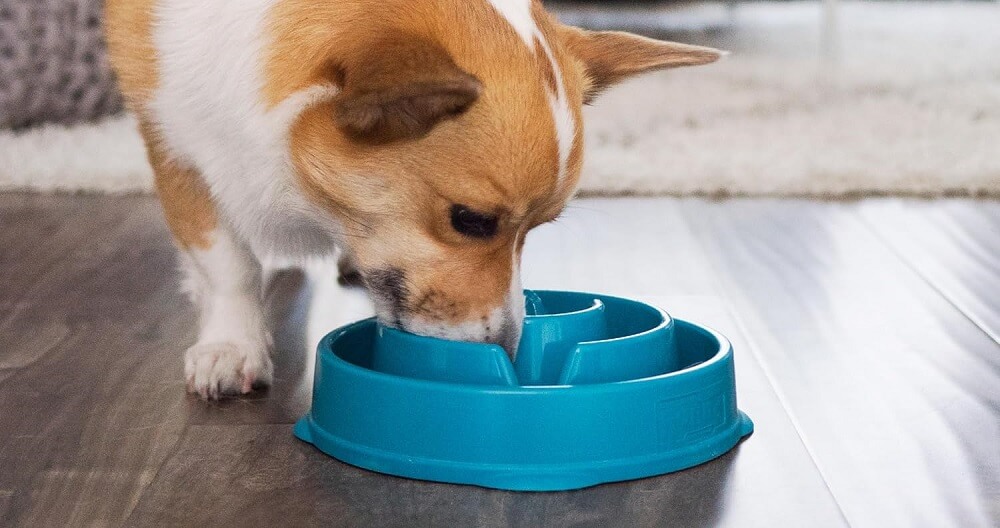When it comes to enhancing your pet’s eating habits, choosing the best slow feeder dog bowl for wet food is a game-changer. These bowls are specially designed to slow down your dog’s eating pace, encouraging healthier digestion and reducing the risk of issues like bloating. With various designs and features available, finding the perfect slow feeder bowl can ensure that your furry friend enjoys their meals while improving their overall health and well-being.
Best Slow Feeder Dog Bowl for Wet Food: Top 5
When searching for the best slow feeder dog bowl for wet food, you are taking a crucial step towards improving your pet’s eating habits. These unique bowls, often referred to as non-slip dog bowls or slow eating dog dishes, are ingeniously designed to moderate your dog’s eating pace, promote healthier digestion, and reduce the risk of issues like bloating and obesity. By introducing such interactive dog bowls into mealtime, you provide your furry friend with both a physical and mental challenge, enhancing their overall well-being.
Here’s a detailed review of the top 5 best-selling and highly reviewed slow feeder dog bowls for wet food, based on current market data and consumer feedback.
1. Best slow feeder dog bowl for wet food
Neater Pet Brands Slow Feed Pet Bowl
[amazon box=”B015G2DU80″/]
This USA-made bowl stands out with its mountain range design, which distributes food evenly and challenges your dog without causing frustration. It has a customizable height with snap-on legs, making it ideal for large dogs.
- Key Features: Frustration-free feeding, USA-made, dishwasher safe.
- Pros: Durable, converts to an elevated bowl, holds up to 6 cups.
- Cons: Rubber foot pads may detach, might be challenging for some dogs.
- Our Take: Great for larger breeds, the customization options for height make it versatile for various needs.
- Use Case: Best for large dogs needing slow feeding without the frustration of overly complicated food puzzles.
2. Best slow feeder dog bowl for large dogs
Le Tauci Ceramic Slow Feeder Dog Bowl
[amazon box=”B0965DBB9Q”/]
This heavy, ceramic option offers multiple internal designs and colors, making mealtime fun and engaging. Its weight keeps it in place for enthusiastic eaters.
- Key Features: Multiple designs, dishwasher and microwave safe.
- Pros: Heavy to prevent sliding, multiple size options.
- Cons: Heavy to move, not suitable for very small breeds.
- Our Take: A stylish and functional choice for dogs that might otherwise move lighter bowls around.
- Use Case: Ideal for homeowners who value aesthetics as well as functionality in pet accessories.
3. Top rated slow feeder bowl for dogs
Outward Hound Fun Feeder Slo Bowl
[amazon box=”B00L3O4JI6″/]
This plastic feeder comes in multiple swirl patterns and sizes, designed to make your dog work for their food, thus slowing down eating significantly.
- Key Features: Multiple patterns, non-slip base, BPA-free.
- Pros: Dishwasher safe, suitable for various dog sizes.
- Cons: Can be difficult to clean thoroughly without pre-soaking.
- Our Take: Excellent for beginners to slow feeders and those with multiple pets due to its ease of use and cleaning.
- Use Case: Suitable for families with dogs of different sizes and feeding needs.
4. Best Pet feeder for slow eating
LickiMat Wobble Slow Feeder Bowl
[amazon box=”B07RFH44JL”/]
Combining a bowl with a lick mat, this feeder offers an extra challenge due to its wobbling motion, and it’s easy to clean being dishwasher-safe.
- Key Features: Combines bowl and lick mat, dishwasher safe.
- Pros: Less messy than traditional mats, adds an extra challenge.
- Cons: Available in only one size and color.
- Our Take: A unique choice for pets that enjoy licking their food, providing entertainment and slow feeding.
- Use Case: Perfect for dogs that need a slight extra challenge and enjoy licking their food from mats.
5. Durable slow feeder dog bowl suitable for wet food
Mr. Peanut’s Stainless Steel Interactive Slow Feed Dog Bowl
[amazon box=”B073NF681T”/]
This stainless steel bowl features an interior that mimics a bundt cake pan, encouraging dogs to chase their food around the bowl.
- Key Features: Dishwasher safe, made from high-quality stainless steel.
- Pros: Durable, shatterproof, and available in multiple sizes.
- Cons: Only available in medium and large sizes.
- Our Take: Durable and effective, it’s excellent for dogs who are rough with their bowls.
- Use Case: Best for medium to large dogs that need durable materials and a moderate eating challenge.
Comparative Analysis for Slow Feeder Dog Bowls
Each of these products offers unique benefits tailored to specific needs and preferences. For example, the Neater Pet Brands bowl is ideal for large dogs and can be adjusted for height, while the Le Tauci bowl’s heavy ceramic build makes it suitable for vigorous eaters who might otherwise tip lighter bowls. The Outward Hound’s variety accommodates different dog sizes and cleaning preferences. Meanwhile, the LickiMat Wobble and Mr. Peanut’s bowls introduce unique challenges through their designs, perfect for dogs needing more mental stimulation during mealtime.
Here’s a quick comparison table summarizing the key points:
| Product Name | Material | Dishwasher Safe | Special Feature | Size Options |
|---|---|---|---|---|
| Neater Pet Brands Slow Feed Bowl | Plastic | Yes | Convertible to elevated bowl | One size |
| Le Tauci Ceramic Slow Feeder Bowl | Ceramic | Yes | Multiple designs | Small, Medium, Large |
| Outward Hound Fun Feeder Slo Bowl | Plastic | Yes | Multiple patterns | Small, Medium, Large |
| LickiMat Wobble Slow Feeder Bowl | Rubber | Yes | Bowl and lick mat combined | One size |
| Mr. Peanut’s Stainless Steel Bowl | Stainless Steel | Yes | Bundt cake design | Medium, Large |
Why Use a Slow Feeder Dog Bowl?
Health Benefits: The primary function of slow feeder dog bowls is to prevent rapid eating, a behavior that can lead to serious conditions like choking, vomiting, and gastric dilatation-volvulus (GDV), also known as bloat. These risks are particularly elevated with wet food, which is consumed more quickly than dry kibble. By extending mealtime, these bowls not only improve digestion but also help manage weight by inducing a longer feeling of fullness.
Behavioral Advantages: Beyond health, slow feeder dog bowls serve as a pet feeder for slow eating that turns mealtime into an engaging game. This mental stimulation is crucial, especially for high-energy dogs who may require additional mental engagement throughout the day.
Choosing the Right Bowl
Material Matters: The best slow feeder dog bowls for wet food are typically made from materials like stainless steel, BPA-free plastic, or silicone. Stainless steel bowls are durable, easy to clean, and resistant to bacteria. Plastic bowls, on the other hand, are lightweight and can be crafted into various intricate designs that slow down eating. Silicone bowls are the safest for younger dogs, offering a soft surface that prevents injuries.
Design and Complexity: The design of the bowl should match your dog’s size and eating habits. Bowls with more complex patterns are suited for smaller breeds or less aggressive eaters, as they make the food more challenging to access. Conversely, larger breeds might need a bowl with wider spaces between ridges to accommodate their bigger snouts.
Size and Capacity: Ensure the bowl you choose can hold an adequate amount of food for your dog’s size and diet. A bowl too small will not provide enough food, while one too large may not effectively slow down your dog’s eating pace.
Maintenance and Care for Your Slow Feeder Bowl
Cleaning and Safety: Ensure that the slow eating dog dish is cleaned after each use to prevent the buildup of bacteria and food residue, particularly when used with wet food. Regular inspection for any signs of wear and tear is also essential to maintain safety.
Cleaning Tips: Clean the bowl after each use to prevent bacterial growth and food residue buildup, especially when using wet food. Most slow feeder bowls are dishwasher safe, but always check the manufacturer’s recommendations.
Inspection for Safety: Regularly inspect the bowl for any signs of wear and tear. Plastic bowls, in particular, should be checked for any cracks or broken pieces that could pose a choking hazard.
Common Questions About Dog Slow Feeder Bowls for wet food
1. How do I train my dog to use a slow feeder bowl?
Begin by introducing the slow feeder during your dog’s usual meal times. Patience is key, as some dogs might initially resist the change. Encourage them by using positive reinforcement like praise or treats.
2. Are there specific slow feeder bowls for wet food?
Yes, some slow feeder bowls are better suited for wet food. These typically have smoother edges to accommodate sloppy meals without the mess.
3. Can all dogs use slow feeder bowls?
While most dogs will benefit from slow feeder bowls, those with medical conditions or dental issues should consult a vet. In some cases, slower feeding might exacerbate certain health problems.
4. How do I introduce my dog to a slow feeder bowl?
Ease your dog into the new eating arrangement by incorporating the slow feeder during regular meal times, using positive reinforcement to encourage their curiosity and patience.
5. What makes a slow feeder bowl suitable for wet food?
Bowls designed for wet food typically have smoother surfaces and fewer crevices, making them easier to clean and more effective at preventing gulp eating.
6. Can slow feeder bowls help with my dog’s digestion?
Absolutely. By slowing down the eating process, these bowls help reduce digestive issues and increase nutrient absorption, making each meal more beneficial for your dog’s health.
7. Are slow feeder bowls suitable for all dog sizes?
Yes, slow feeder bowls come in various sizes and designs to accommodate different dog breeds and sizes. It’s important to choose a bowl that matches your dog’s eating style and muzzle size. Smaller bowls with intricate patterns are ideal for small to medium dogs, while larger bowls with simpler, more robust designs suit larger breeds.
8. Can slow feeder dog bowls help with weight management?
Absolutely. By slowing down the rate at which your dog eats, these bowls help promote a feeling of fullness and can prevent overeating, which is crucial for weight management. This is especially beneficial for dogs on a calorie-restricted diet or those prone to obesity.
9. What materials are best for slow feeder dog bowls?
Most slow feeder bowls are made from stainless steel, silicone, or food-grade plastic. Each material has its benefits: stainless steel is durable and easy to clean, silicone is soft and safe for puppies, and plastic can be molded into various slow-feeding patterns.
10. How often should I clean the slow feeder dog bowl?
Cleaning the bowl after every meal is ideal, especially with wet food, as it tends to stick and can harbor bacteria. Regular cleaning ensures that your dog’s feeding area stays sanitary and is also an opportunity to inspect the bowl for any wear or damage.

